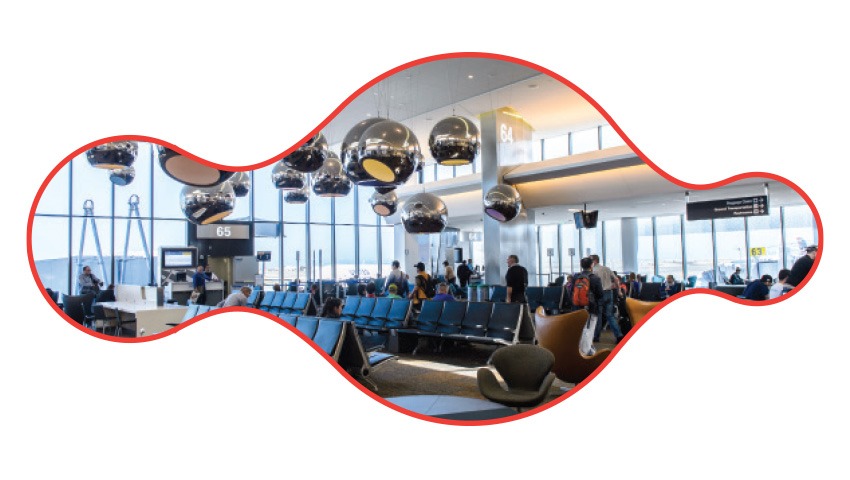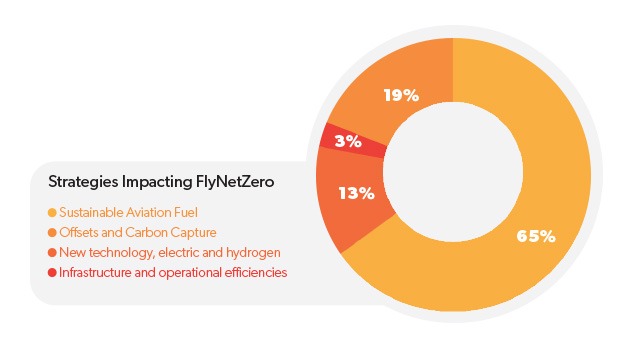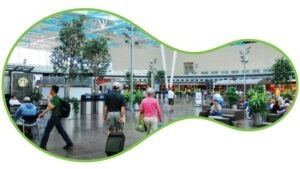Sustainability Initiatives are Soaring at 40,000 ft. and Climbing
It’s no secret that air travel is an integral part of the meetings and events industry. It provides people and organizations around the globe the opportunity to gather with a wide network, often in unforgettable locations.
Meeting professionals planning all those business events can now rest easier knowing that advances in everything from recycled fuel to investments in renewable power are curbing the 2-3% of all global CO2 emissions attributed to planes and airport operations each year.
What should you look for when considering the environmental footprint of your event? We rounded up examples of green travel practices from around the country so you will know what questions to ask when sourcing your next sustainable meeting.
Fly Net Zero

On October 4th, 2021, at the 77th Annual International Air Transport Association (IATA) General Meeting, a “Fly Net Zero” resolution set the lofty goal of achieving net-zero carbon emissions by 2050. Organizations across the air travel industry, including airlines, airports, air navigation services and manufacturers are coordinating to reduce their carbon emissions to make that vision a reality.
Read More: You Can Go Net Zero
Conscientious meeting professionals can help by considering sustainable options in their planning. With the help of government programs such as the Federal Aviation Administration (FAA), which offers funding through their Airport Improvement Program, airports across the U.S. are making major strides towards this goal through an array of sustainable initiatives.
Look for Airport Carbon Accreditation
At their 2009 Annual Assembly, Airports Council International (ACI) Europe launched the Airport Carbon Accreditation program. It’s the only institutionally endorsed, airport-specific carbon standard, and it enables the global airport industry to reduce its carbon footprint by individually assessing airports and recognizing their efforts to reduce their carbon emissions through six levels of certification: mapping, reduction, optimization, neutrality, transformation and transition.
Airports can apply for certification at one of these six levels and will be accredited on one of four main progressive levels: 1. Mapping; 2. Reduction; 3. Optimization; and 4. Transformation. Airports at levels three and four can offset their residual emissions to achieve level 3+ (Neutrality) and 4+ (Transition).
Airports can make positive impacts by installing more energy-efficient infrastructure, investing in hybrid, electric or renewable gas-powered service vehicles, implementing green landing processes and so much more. The ACI website provides a comprehensive list of airports participating in the program.
Sustainable Jet Fuel

Produced from several sources, including but not limited to agricultural and forestry residues, wet wastes and non-food crops cultivated on marginal land, Sustainable Aviation Fuel (SAF) is a form of renewable fuel that offers an alternative to standard kerosene-based jet fuels. These fuels can reduce carbon emissions by up to 80%.
Read More: Seeking Sustainable Venues
IATA estimates that the widespread use of sustainable aviation fuel would contribute 65% of the effort towards the Fly Net Zero by 2050 goal.

Beyond reducing carbon emissions, SAF also contains fewer aromatic components, so it burns cleaner in aircraft engines and emits lower levels of harmful compounds that are released during takeoff and landing. Farmers growing crops for SAF production see higher revenues and the crops themselves can help to control erosion, increase biodiversity and store carbon in the soil. SAF produced from wet wastes, such as manure, reduces the amount of methane gas in the atmosphere.
In 2023, over 490,000 flights have been operated in aircrafts running on SAF, compared to 500 in 2019.
San Francisco International Airport (SFO)
San Francisco International Airport (SFO) is leading the way for airports across California and North America in their use of SAF. SFO receives the highest volume of SAF in the world. In 2018, the airport’s SAF-fueled gateway flights had nearly 400,000 gallons of SAF delivered, avoiding around 100 metric tons of CO2 emissions. For context, one metric ton of CO2 is equivalent to the amount produced by an average car in three months.
In the face of infrastructure and supply chain challenges, 10 partner airlines and fuel producers, representing over 66% of all SFO flights pledged to increase SAF usage. The signatories make up the SAF Stakeholder Working Group, who, alongside other SAF advocates, successfully lobbied the California Air Resources Board to offer the opt-in inclusion of SAF by expanding the Low Carbon Fuel Standard (LCFS). Because of this, since 2019, the LCFS offers SAF producers a tax credit of roughly $1.25 per gallon of SAF produced.
Read More: Don’t Believe Everything You See on Twitter About a San Francisco Meeting Apocalypse
Sustainability and Environmental Policy Director Eric Cooke says, “SFO has a roadmap, and is actively delivering net zero energy, waste, carbon and water projects across campus. Since 2018, SFO has studied, convened and advocated to accelerate the commercialization and uplift of SAF as the key solution to reduce the climate impacts of our sector.”
A fuel switch to 5% SAF by 2025 has the potential to reduce greenhouse gas emissions by up to 2 million metric tons. With this goal in mind, SFO convenes a SAF Coalition that advocates for additional incentives at the state and federal level to increase SAF usage. SFO also co-chairs an Airports Council International SAF task group to standardize how airports can expand the SAF market.
Solar Power
Solar power is one of the most widely used renewable energy sources.
Solar panels absorb the solar radiation—light—emitted by the sun through photovoltaic (PV) cells in the panel, in which photons (light particles) knock electrons from atoms to create an electrical charge; and voila! Electricity.

Producing electricity through solar power emits no greenhouse gases. As solar power is so widespread, and has been for some time, methods to recycle degraded solar panels have increased, so their carbon footprint only shrinks. They are expensive to install initially, but reduce the amount spent on energy production in the long run; on average, it takes about five to 15 years following installation to break even. Of course, the amount of light that touches different areas of the earth varies, but in areas with abundant or even moderate sunlight, solar panels are a no-brainer.
Indianapolis International Airport (IND)

International Airport
The Indianapolis Airport Authority received the largest FAA Grant of 2023—a whopping $22.58 million. They plan to put the funds towards the first 25% of a multi-phased program to transition the airport terminal’s energy consumption to renewable energy generated onsite.
Indianapolis International Airport already boasts one of the largest solar farms on any airport property in the world, with 87,478 solar panels across 183 acres, providing enough electricity to power 3,675 average American homes per year. In this first phase of the sustainable renovation project, they will install yet more solar panels on a metal canopy in the surface parking lot areas near the terminal. This phase will also see infrastructure to provide backup battery storage for use during nighttime hours and times of disruption or outages.
IAA director of Environment and Sustainability Todd Cavender says, “We’re just getting started. As we build out this sustainable infrastructure, it has the potential to expand in the future with the goal of meeting 100% of the terminal’s energy needs.”
Indianapolis International Airport also has plans for a $190 million runway and taxi reconstruction project that will include the first-ever use of FAA-approved carbon capture technology in the runway pavement: CarbonCure. CarbonCure is a Nova Scotia company who manufactures carbon removal or utilization technologies that introduce recycled CO2 into fresh concrete, where it is permanently stored rather than emitted into the environment.
Geothermal Energy

Geothermal systems are a renewable heating and cooling source that uses the thermal energy stored in rocks and fluids in the center of the earth, generated during the original formation of the planet and continuing radioactive decay.
Geothermal wells are drilled into underground reservoirs. Water flowing through pipes in a building is pumped into the geothermal wells to cool before returning to the building to produce cooler air. In the winter, the same process pumps cool water from the pipes into the wells where it is warmed before returning warmer air to the building, all using the natural temperature of the earth.
A geothermal energy system produces only around one-sixth of the carbon dioxide emitted by a clean natural-gas power plant and can run 24/7 as opposed to other renewable energy sources like solar and wind, which can face interruptions due to changes in weather.
Louisville Muhammad Ali International Airport (SDF)
In 2021, Louisville Muhammad Ali International Airport set out on a $21.7 million project to build the largest geothermal energy system of any airport in the country.
648 geothermal wells drilled 500 feet deep into the earth on the east side of the airfield will heat and cool the Jerry E. Abramson Terminal. As of 2023, the geothermal wells have all been installed and the wellfield has been paved over to make space for additional ramp parking and aircraft, increasing the number of travelers the airport can accommodate. They are now in the process of installing the pipe connections between the wellfield and the terminal.
The geothermal system will use 40% less energy than an HVAC system and cut carbon emissions by 80% by reducing pollutants like ozone, carbon monoxide and other particulate matter created by burning natural gas. It requires less maintenance and has an operating life two to three times longer than commercial HVAC systems, saving around $400,000 per year in heating and cooling operating costs.
The FAA awarded SDF $10.6 million as part of their Voluntary Airport Low Emissions Grant Program. The airport is using this award to fund the geothermal wells and piping infrastructure that will accompany them.
This article appears in the September/October 2023 issue. You can subscribe to the magazine here.




